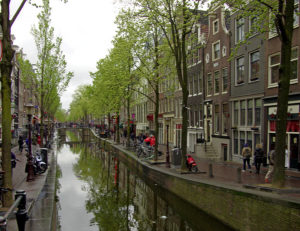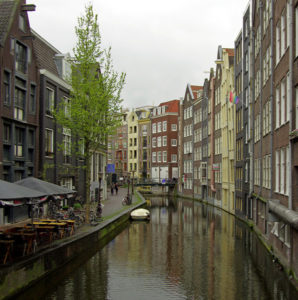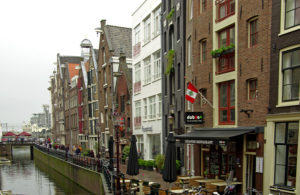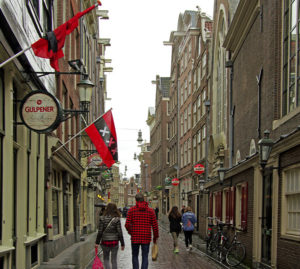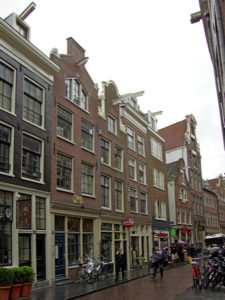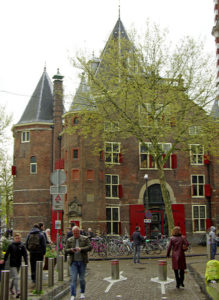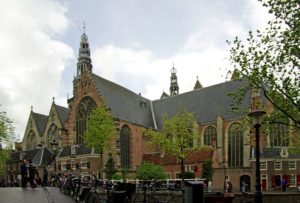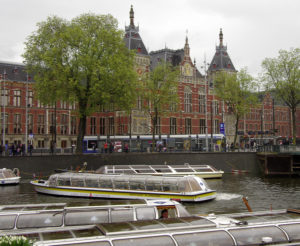In the C13th, Amsterdam was originally a small fishing village at the mouth of the Amstel river. This was a very low lying area and water levels were controlled by system of dykes and polders. The first permanent buildings were built on terps, man made mounds high enough to provide protection from the flood waters. Wooden piles were sunk through the boggy soil to firm sand beneath. Over the years, some of the piles have begun to subside and many of the houses in the centre of Amsterdam now have a decided lopsided appearance.
Amsterdam began to grow rapidly in the C14th after the discovery of a new method of curing herring. This preserved the fish longer allowing it to be exported. The port also handled beer from Hamburg. Elaborate waterside houses with warehouses were built long the waterfront and canals.
During the C17th, Amsterdam was a major port for the Dutch East India Company which had a trading empire stretching from Indonesia to the Americas. By the C17th the population had soared and three great new canals were built in a triple ring around the city, to reclaim more land for building. Many of the houses built then still have their tegels for lifting goods from canal boats into the storage attics.
The Netherlands remained wealthy even after the decline of the fortunes of the East India and West India companies. Its ships became commercial cargo carriers. By the end of the C18th, the city had become the world’s financial capital. As a result of its tolerance to minorities, the city was flooded with immigrants, including many Jews.
Napoleon established his brother Louis as King of the Netherlands, and Amsterdam declined in importance. There was little sign of enterprise or investment. Attempts were made to revive its fortunes by digging a canal to the North Sea but it continued to slide into a period of obscurity.
The House of Orange was brought back after the death of Louis. Fortunes began to revive, along with the diamond trade which thrived in the late C19th cutting diamonds brought from South Africa. The splendid railway station dates from the end of the C19th and has a Gothic Revival facade. It is also the centre of an integrated transport network with trams and ferries.
At the end of the Second World War, Amsterdam suffered a series of social problems. The Netherlands has a long tradition of religious and political tolerance and a culture that ‘no-one should be harmed by the action of others’. This made it a mecca for the 1960s hippy culture and it became a centre of drug use and trafficking. It even has a Hash, Marihuana and Hemp Museum. This has a small cultivation area and police sometimes raid the museum removing exhibits. It also has a well know Red Light District and prostitutes can be seen working. This is a popular tourist attraction…
Amsterdam is well known for its canals and canal cruises are popular with visitors. Canals are linked by a network of narrow streets. The bicycle is king here.
Nieuwmarkt bordered by many fine C17 and C18th gabled houses. This is the site of a daily market and has a lot of cafes. It is dominated by De Waag. This is the only remaining medieval gate into the city and later became the weigh house.
The C13th Oude Kierk is the oldest church in Amsterdam and dominates the red light district. It is still used for services and also hosts a contemporary art programme with exhibitions, performances and music.
Amsterdam is a city to be explored on foot, or possibly by bike, or public transport. I only had a few hours here, so didn’t have chance to visit Anne Frank’s House or any of the major art galleries Amsterdam is famous for. I spent the time walking the canals by myself – at no time did I feel worried or unsafe. I also visiting the less well know “the Church in the Attic.”:http://wasleys.org.uk/eleanor/otherholidays/holland/day_five/index.html Museum Ons’ Lieve Heer op Solder.
